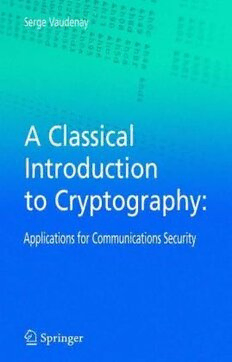Table Of ContentA CLASSICAL
INTRODUCTION TO
CRYPTOGRAPHY
Applications for
Communications Security
A CLASSICAL
INTRODUCTION TO
CRYPTOGRAPHY
Applications for
Communications Security
by
Serge Vaudenay
SwissFederalInstituteofTechnologies(EPFL)
Serge Vaudenay
Ch. de Riant-Mont 4
CH-1023 Crissier
Switzerland
Library of Congress Cataloging-in-Publication Data
A C.I.P. Catalogue record for this book is available
from the Library of Congress.
A CLASSICAL INTRODUCTION TO MODERN CRYPTOGRAPHY
Applications for Communications Security
by Serge Vaudenay
Swiss Fédéralel Institute of Technologies (EPFL)
ISBN-10: 0-387-25464-1 e-ISBN-10: 0-387-25880-9
ISBN-13: 978-0-387-25464-7 e-ISBN-13: 978-0-387-25880-5
Printed on acid-free paper.
(cid:164) 2006 Springer Science+Business Media, Inc.
All rights reserved. This work may not be translated or copied in whole or
in part without the written permission of the publisher (Springer
Science+Business Media, Inc., 233 Spring Street, New York, NY 10013,
USA), except for brief excerpts in connection with reviews or scholarly
analysis. Use in connection with any form of information storage and
retrieval, electronic adaptation, computer software, or by similar or
dissimilar methodology now know or hereafter developed is forbidden.
The use in this publication of trade names, trademarks, service marks and
similar terms, even if the are not identified as such, is not to be taken as
an expression of opinion as to whether or not they are subject to
proprietary rights.
Printed in the United States of America.
9 8 7 6 5 4 3 2 1 SPIN 11357582, 11426141
springeronline.com
ToChristineandEmilien
Contents
Preamble . . . . . . . . . . . . . . . . . . . . . . . . . . . . . . . . . . . . . . . . . . . . . . xv
1 PrehistoryofCryptography . . . . . . . . . . . . . . . . . . . . . . . . . . . . . . 1
1.1 FoundationsofConventionalCryptography.................... 1
1.1.1 TheOriginsofCryptography ......................... 1
1.1.2 KeyWords........................................ 2
1.1.3 Transpositions,Substitutions,andSecretKeys............ 4
1.1.4 VernamCipher .................................... 7
1.1.5 Enigma:TowardIndustrialCryptography................ 8
1.2 RootsofModernCryptography ............................. 10
1.2.1 CryptographicProblems:TheFundamentalTrilogy........ 10
1.2.2 AssumptionsofModernCryptography.................. 11
1.2.3 AdversarialModels................................. 12
1.2.4 CryptographyfromVariousPerspectives ................ 13
1.2.5 Methodology...................................... 15
1.3 (cid:1)TheShannonTheoryofSecrecy............................ 15
1.3.1 (cid:1)SecrecyofCommunication.......................... 15
1.3.2 (cid:1)Entropy ......................................... 17
1.3.3 (cid:1)PerfectSecrecy ................................... 18
1.3.4 (cid:1)ProductCiphers................................... 19
1.4 Exercises............................................... 19
2 ConventionalCryptography . . . . . . . . . . . . . . . . . . . . . . . . . . . . . . 21
2.1 TheDataEncryptionStandard(DES)......................... 22
2.2 DESModesofOperation.................................. 25
2.2.1 ElectronicCodeBook(ECB)......................... 25
2.2.2 CipherBlockChaining(CBC) ........................ 26
2.2.3 OutputFeedback(OFB) ............................. 27
2.2.4 CipherFeedback(CFB).............................. 29
2.2.5 CounterMode(CTR) ............................... 30
2.3 MultipleEncryption ...................................... 30
2.3.1 DoubleMode...................................... 30
2.3.2 TripleMode....................................... 31
2.4 AnApplicationofDES:UNIXPasswords..................... 31
viii Contents
2.5 ClassicalCipherSkeletons................................. 32
2.5.1 FeistelSchemes.................................... 32
2.5.2 Lai–MasseyScheme................................ 33
2.5.3 Substitution–PermutationNetwork..................... 36
2.6 OtherBlockCipherExamples .............................. 37
2.6.1 (cid:1)FOX:ALai–MasseyScheme ........................ 37
2.6.2 (cid:1)CS-CIPHER:ASubstitution–PermutationNetwork....... 40
2.7 TheAdvancedEncryptionStandard(AES) .................... 42
2.8 StreamCiphers.......................................... 46
2.8.1 StreamCiphersversusBlockCiphers................... 46
2.8.2 RC4............................................. 46
2.8.3 A5/1:GSMEncryption.............................. 48
2.8.4 E0:BluetoothEncryption............................ 50
2.9 BruteForceAttacks ...................................... 51
2.9.1 ExhaustiveSearch.................................. 52
2.9.2 DictionaryAttack .................................. 53
2.9.3 CodebookAttack................................... 54
2.9.4 (cid:1)Time–MemoryTradeoffs............................ 54
2.9.5 Meet-in-the-MiddleAttack........................... 59
2.10 Exercises............................................... 60
3 DedicatedConventionalCryptographicPrimitives . . . . . . . . . . . . . . 63
3.1 CryptographicHashing.................................... 63
3.1.1 Usage............................................ 63
3.1.2 ThreatModels..................................... 64
3.1.3 FromCompressiontoHashing........................ 65
3.1.4 ExampleofMD5................................... 66
3.1.5 ExamplesofSHAandSHA-1......................... 67
3.2 TheBirthdayParadox..................................... 70
3.3 (cid:1)ADedicatedAttackonMD4 .............................. 74
3.4 MessageAuthenticationCodes.............................. 78
3.4.1 Usage............................................ 78
3.4.2 ThreatModel...................................... 79
3.4.3 MACfromBlockCiphers:CBC-MAC.................. 80
3.4.4 (cid:1)AnalysisofCBC-MAC............................. 82
3.4.5 (cid:1)MACfromStreamCiphers.......................... 86
3.4.6 MACfromHashFunctions:HMAC.................... 88
3.4.7 AnAuthenticatedModeofOperation................... 90
3.5 CryptographicPseudorandomGenerators ..................... 92
3.5.1 UsageandThreatModel............................. 92
3.5.2 (cid:1)CongruentialPseudorandomGenerator ................ 92
3.5.3 PracticalExamples ................................. 93
3.6 Exercises............................................... 95
Contents ix
4 (cid:1)ConventionalSecurityAnalysis . . . . . . . . . . . . . . . . . . . . . . . . . . . 97
4.1 (cid:1)DifferentialCryptanalysis................................. 97
4.2 (cid:1)LinearCryptanalysis..................................... 103
4.3 (cid:1)ClassicalSecurityStrengthening ........................... 111
4.3.1 (cid:1)Nonlinearities .................................... 111
4.3.2 (cid:1)CharacteristicsandMarkovCiphers................... 112
4.3.3 (cid:1)TheoreticalDifferentialandLinearCryptanalysis ........ 114
4.3.4 (cid:1)AdhocConstruction............................... 120
4.4 (cid:1)ModernSecurityAnalysis................................. 123
4.4.1 (cid:1)DistinguishabilitySecurityModel..................... 123
4.4.2 (cid:1)TheLuby–RackoffResult........................... 125
4.4.3 (cid:1)Decorrelation..................................... 126
4.5 Exercises............................................... 132
5 SecurityProtocolswithConventionalCryptography . . . . . . . . . . . . . 135
5.1 PasswordAccessControl .................................. 135
5.1.1 UNIXPasswords................................... 136
5.1.2 BasicAccessControlinHTTP........................ 136
5.1.3 PAPAccessControlinPPP........................... 137
5.2 Challenge–ResponseProtocols.............................. 137
5.2.1 DigestAccessControlinHTTP....................... 138
5.2.2 CHAPAccessControlinPPP......................... 140
5.3 One-TimePassword ...................................... 140
5.3.1 LamportScheme................................... 140
5.3.2 S/KeyandOTP.................................... 141
5.4 KeyDistribution......................................... 142
5.4.1 TheNeedham–SchroederAuthenticationProtocol......... 142
5.4.2 Kerberos ......................................... 143
5.4.3 (cid:1)MerklePuzzles ................................... 145
5.5 (cid:1)AuthenticationChains.................................... 145
5.5.1 (cid:1)MerkleTree...................................... 145
5.5.2 (cid:1)TimestampsandNotary............................. 147
5.6 WirelessCommunication:TwoCaseStudies................... 148
5.6.1 TheGSMNetwork ................................. 148
5.6.2 TheBluetoothNetwork.............................. 150
5.7 Exercises............................................... 153
6 AlgorithmicAlgebra . . . . . . . . . . . . . . . . . . . . . . . . . . . . . . . . . . . 155
6.1 BasicGroupTheory...................................... 155
6.1.1 BasicSetTheory................................... 155
6.1.2 Groups........................................... 157
6.1.3 GeneratingaGroup,ComparingGroups ................ 158
6.1.4 BuildingNewGroups............................... 159
6.1.5 FundamentalsonGroups............................. 159

